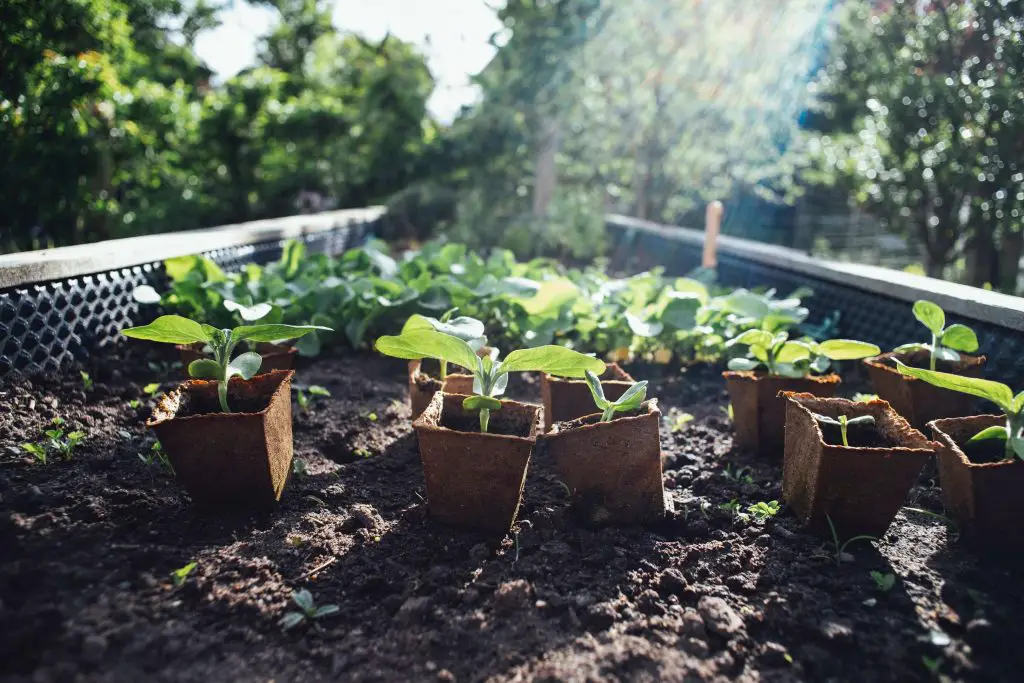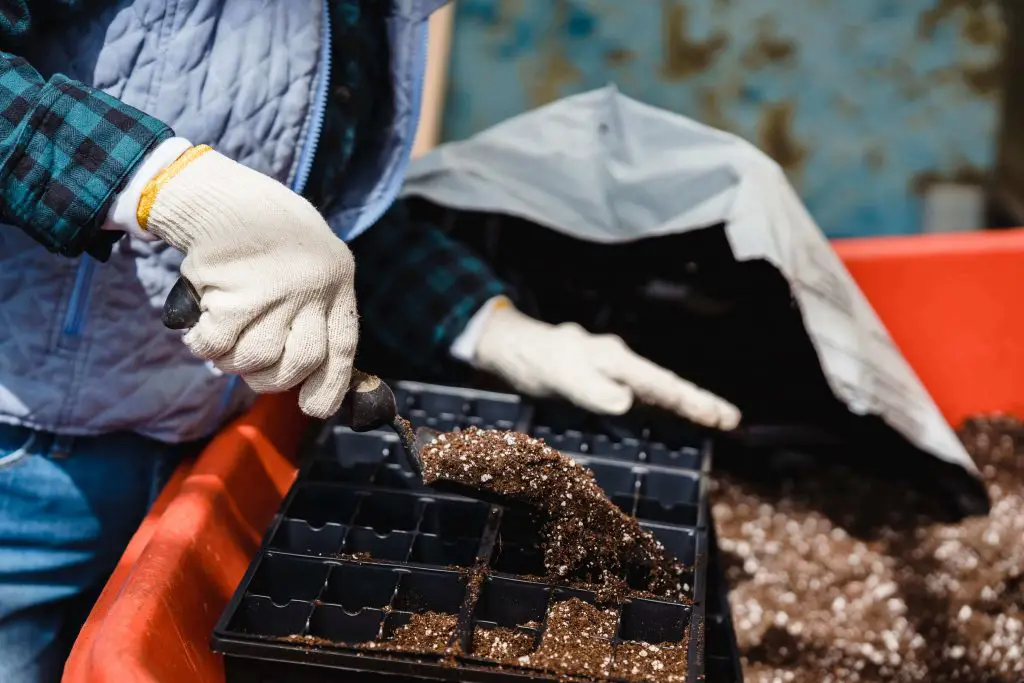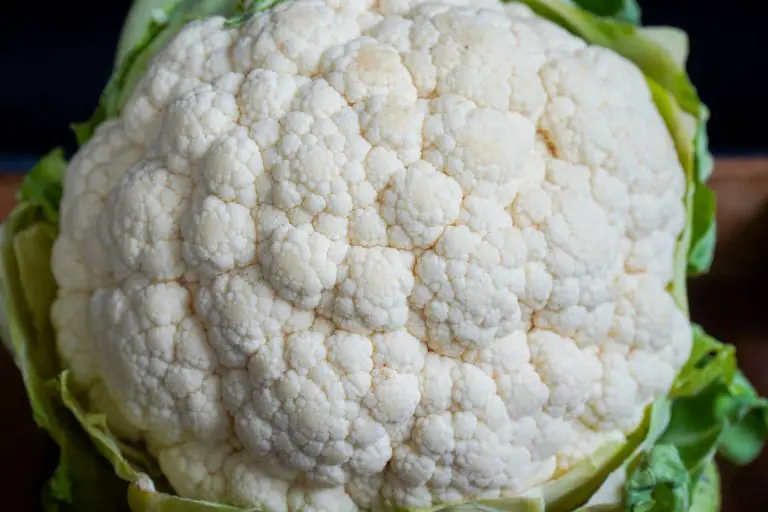Growing Tomatoes In Fabric Pots [Step By Step Guide 2022!]
Did you know that growing tomatoes in fabric pots is one of the best solutions to all your space, plant productivity, and not to mention, pests problems too?
The best part is that you can grow them anywhere without worrying about any shortage of space!
Yes, you heard it right
While plastic pots may be weatherproof and durable, fabric pots for tomatoes are less maintenance, environmentally friendly, and provide better root development for healthier plant growth.
Read on to find out all the reasons why you should opt for a fabric pot, how to get started, and care methods for successfully growing tomatoes in fabric pots.

Summary of Growing Tomatoes In Fabric Pots
In this article, I will take you on a deep dive into:
- How To Grow Tomatoes in Fabric Pots
- What Are Fabric Pots
- Benefits of Using A Fabric Pot
- Types of Tomatoes To Grow In Fabric Pots
- Types of Fertilisers To Grow In Fabric Pots
- How To Support Tomato Plants In Fabric Pots
Affiliate Link Disclaimer
Some of the links here are affiliate links, and I may earn if you click on them, AT NO EXTRA cost to you. I hope you find the information here useful! Thanks!
Related Posts
- How To Grow Cherry Tomatoes In Pots
- How To Grow Beefsteak Tomatoes In A Pot
- Beefmaster Tomato Plants: 8 Simple Steps To Grow Them 2022
- 27 Plants That Don’t Lose Leaves In Winter! +Growing Tips [2023]
How To Grow Tomatoes In Fabric Pots: A Step-By-Step Guide
Even when you don’t have access to a garden or are confined to a limited house space – with just fabric tomato pots as your working platform, you are all set to cultivate a healthy plant with these step-by-step guides.
Prep Time
10 minutes
Difficulty Level
Easy
Tools
1. Trowel
2. Garden scissors
3. Cultivator
Materials
1. 25-inch heavy-duty saucer (varies on container size)
2. 10 – 20 gallon container (may vary according to your preference)
3. 1.5 to 3 cubic feet of potting soil (varies on container size)
4. ½ cup of tomato/vegetable fertilizer
5. ½ cup of fish/bone compost
6. Handful of crushed eggshells
7. ½ cup of an all-purpose fertiliser
10. Organic mulch
Step-by-step guide
1. Decide if you want to grow determinate or indeterminate tomatoes. Let the duration of the season and space guide you.
2. Start with a healthy transplant of the seedlings. Repotting will aid your tomato plants in developing larger root masses that can withstand vulnerabilities, pests resistant to any other diseases.
3. Choose a fabric pot over a plastic pot. Fabric pots for tomatoes have been proven to be more beneficial in providing better air pruning to form new, fibrous feeder roots.
4. Use high-quality potting soil that consists of a good combination of absorption, breathability, and moisture retention. Prepare the gallon container to fill it with potting soil of your choice.
5. Feed your tomato plant and soil well. Tomatoes are heavy feeders and thrive on nutrients for good production in the long season.
All you need is to combine these composts with ½ cup of all-purpose fertiliser, ½ cup of fish/bone meal, and a handful of crushed eggshells to cultivate a healthy breed of tomatoes.
6. Bury the stem of the tomato plant in the centre and fill the remainder of the pot to the brim with more potting soil. Gently shake the container to settle the soil and rake in the ½ cup of all-purpose fertiliser around the base of the stem.
7. Water consistently and thoroughly until the soil is evenly moist. It takes a surprisingly large amount of water to fully saturate the soil for the first time.
Too much or too little water can stunt your plants’ growth, so be sure to allow the excess water to be drained out from the bottom and check the soil again in a few days’ time for water level consistency.
8. Add a support structure to avoid damaging the roots before the plant grows too large. Whichever support you decide, do not wait until the very last moment of need to install it in place as it’ll be much harder to wrangle a mature tomato plant.
9. Mulch the soil by at least 2 inches as it helps to retain the soil’s moisture.
10. Fertilise the tomatoes consistently throughout the season. A word of advice is to start feeding your tomato plant about six weeks in and follow the directions on your care package for proper application.

What Are Fabric Pots?
Similar to a reusable grocery bag, fabric pots or also known as fabric tomato grow bags are made from a type of BPA-free, lightweight fabric (usually double-layer polypropylene) that is breathable.
Since it’s well-aerated, it has a better drainage system than the traditional pots. They also make a superior physical barrier that protects the root systems from harsh weather conditions, diseases, and pests.
Another fun fact is that fabric pots are generally soft and have a felt-like texture to them. It comes in various widths and heights, making it highly versatile to accommodate any plant size of your choice.
With its durability, the pot can be filled with any growing medium that ranges from soil, bark, wood chips, and even composted green waste. I highly recommend giving this method a try for growing tomatoes.
Benefits Of Using A Fabric Pot
Whether you have insufficient garden space, no garden space at all, or you’re simply looking into trying a different method, understanding the benefits of using a fabric pot can make a difference in your journey to grow successful tomatoes for the summer.
1. Durability
Did you know that fabric pots, with thorough cleaning and proper care, can be reused for more than 5 to 6 growing cycles?
The nature of the fabric allows room for washing, and the marine-grade stitching keeps them intact no matter the weather.
You won’t have to worry about your pots’ sudden cracking or even if you accidentally drop them.
2. Air Root Pruning
Conventional rigid plastic pots do not offer any air circulation, thus forcing the roots to be quickly root-bound in search of nutrients but with fabric pots, air flows freely inside the pots and the roots are naturally self-pruned.
This in turn activates the growth of the fibrous roots, allowing room for a healthier expansion of the root system.
3. Drainage
All living things including plants need a sufficient supply of water, but an excessive amount may lead to disastrous outcomes.
Water ponding in a pot will cut off the oxygen supply to the roots, leading to soil borne diseases responsible for hurting the root rot.
If you’re the type who tends to overwater, fret not as with fabric pots, excess water can be drained easily!
4. Aeration
Oxygen is equally as important as carbon dioxide as it is used to speed up the metabolic process of taking up nutrients.
Growing tomatoes in fabric grow bags material, in general, is porous, allowing air to enter more efficiently covering all container surfaces to the root zone, thus resulting in more robust and vibrant plant growth.
5. Mobility (flexibility)
No matter how seasoned (see what I did there?) you are in the planting world, one challenge you would always encounter is when the need arises to move your potted plants around.
Standard pots aren’t ergonomically designed to be lifted by our mere hands, it’s a lot of work that may strain your muscles. Many grow bags come with handles, making it slightly easier for us to lift and move them around.
With the variance in the garden temperatures, location, sunlight, and seasonal changes every year, planting with fabric grow bags makes it easier for us to maneuver our plants in response to the ever-changing environment.
6. Temperature Control
Exposure to indoor lights or outdoor sun can cause a build-up of heat surrounding your plant. Plastic pots are not designed to release heat that’s trapped inside, therefore the solution to the problem is with fabric pots.
With fabric grow bags, temperatures are well regulated through the evaporative cooling process from the walls of the container.
7. Quality
Constructed using a non-woven geotextile material and reinforced with high-quality thread, rest assured that these sturdy fabric pots will last for several years without any worries that the quality will be compromised.
Similar to clothes, fabric grows bags can be reused even after tons of washing, rinsing, and repeating the process multiple times.
8. Storage Efficiency
Growing plants on its own are already space-consuming but if you don’t have that extra space for regular plastic pots, you can consider growing tomatoes in fabric pots!
They are just as functional and sturdy as the regular pots and are so good at being storage efficient. These fabric grow bags can be folded, stored neatly, and reused any time of the season.
9. Cost Saving
Since plastic pots are not as sturdy and long-lasting, fabric grows bags, in the long run, are cost-efficient in that you don’t have to keep replacing them.
It’s a good investment to start with and you can see how impressive the results can be when you opt for a fabric grow bag.
Types Of Tomatoes To Grow In Fabric Pots
The best types of tomatoes to grow in fabric pots are called ‘determinate’ or commonly known as the bush, patio, or compact plants. These types can grow up to no more than 3 to 4 feet tall, making them a practical choice to be nurtured in tight spaces.
This being said, you can still choose to grow indeterminate tomatoes if you provide good support for the vines, as well as a large enough fabric pot size for tomatoes to contain the growth size.
A good rule of thumb to choose between determinate and indeterminate is when you have a limited footprint and a short growing season.

Types Of Fertilisers To Use In Fabric Pots
When we feed the plants, we also need to remember to feed the soil. Ensuring the plants receive a well-rounded nutrient source is the best way to encourage rapid plant growth.
Opt for a naturally-sourced fertiliser such as compost to look for plant fertiliser.
Its high organic content is an ideal food source for soil microbes. Soil microbes contain a multitude of micro and macronutrients that are vital for plant growth.
Fill the fabric grow bags for tomatoes with a 60/40 ratio blend of high-quality potting soil and compost to aid the cultivation.
With the combination of aerated fabric pots and the right type of fertilisers, you’ll be left with nothing short but amazing results.
How To Support Tomato Plants in Fabric Pots
All plants, even tomatoes in fabric pots will require support as they grow vertical. To avoid any damage to the roots, the recommended tip is to add structural support at an earlier stage before the plant grows too big.
You can achieve this by using tomato ladders or a square tomato cage (which can be folded down for storage convenience) to allow the vines to twine around them.
Some important tips in ensuring that the added supports are stable are to connect them to a fixed structure or to slide some stakes into the bag itself.
The easiest option is to get frames or cages big enough to sit firmly inside the fabric containers to avoid the plants from falling over.
How Often Do You Water Tomato Plants In Fabric Pots?
Wondering how often do you water tomato plants in fabricpots? Tomato plants in fabric pots should be watered daily, sometimes twice a day as the temperature increases and when the plant is actively bearing fruits. Tomato plants grown in fabric pots generally need more water than garden tomatoes.
Can I Grow Vegetables In Fabric Pots?
So, can I grow vegetables in fabric pots? The short answer is yes, you can grow various vegetables in fabric pots. They are ideal for any plant that has small root structures. Fabric pots, in general, prevent root circling and promote air pruning for the roots to grow.
Do Fabric Grow Pots Work?
Do fabric grow pots work? Fabric grows pots do work wonders as it provides an excellent drainage system. When you use plastic pots, it’s easier for the plants to drown but with this improved breathable product, say goodbye to any pathogens or mould issues.
Conclusion
There you have it! All the tips and tricks in successfully growing tomatoes in fabric pots.
What makes fabric containers a hit among urban gardeners, is it’s reusable and easy to use, and it also provides consistent results over time.
If you like to change the type of plant for the next growing season, all you need to do is remove the potting soil, give the fabric bags a good wash, and leave it to dry completely.
Once done, simply fold and stow away the bags in a storage bin until you’re ready to grow more plants in the future. Easy as that!
Do consider giving fabric containers a go and let me know how it went! I would love to hear your thoughts and opinions on the best fabric pots journey.
Related Posts
- How To Grow Tomatoes On A Fence: 6 Step Guide [2022]
- How To Grow Tomatoes Without A Garden + Unique Growing Tips! [2022]
- How To Save A Dying Tomato Plant (+Growing Tips)















![15 Companion Plants For Cantaloupe & What To Avoid! [2023]](https://aboveandbeyondgardening.com/wp-content/uploads/2022/11/companion-plants-for-cantaloupe-2-768x512.jpg)

![How To Dig Steps Into A Hill [5 Easy Steps!]](https://aboveandbeyondgardening.com/wp-content/uploads/2021/10/How-To-Dig-Steps-Into-A-Hill-768x512.jpg)